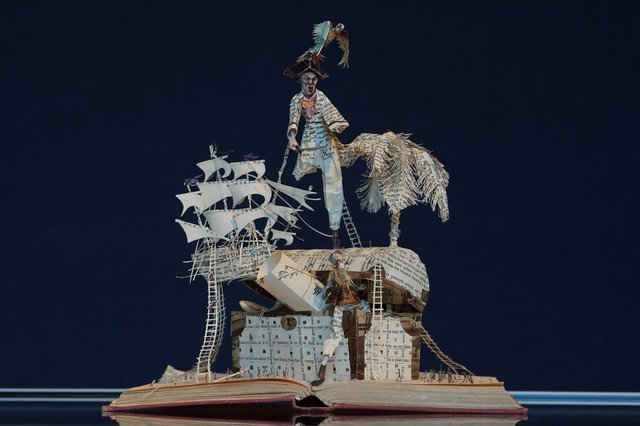Not Your Banksy
By Madina Burkhanova
The overlap between literature and the visual arts is a common one; as two of the most prolific forms of emotional expression, they coincide more than one would imagine. As children, we are raised on picture books, and with the recent popularity of visual teaching and learning, the bond between these crafts grows only stronger.
Now, jumping just over a decade into the past: an enigmatic woman places intricate sculptures of books across Edinburgh at various cultural venues to mark Scotland’s first annual book week, all found between 2012 and 2013. The sculptures literally emerge from the books and depict their respective storylines. What do the books have in common? Each of the selected narratives is native to Scotland; among the variety are Treasure Island and Whisky Galore, written by Scottish authors Robert Louis Stevenson and Compton Mackenzie. The sculptures tease out questions that reverberate internationally - why, and for who?
Unknown, Peter Pan, 2011-2021, sculpture.
In 2015, the BBC was able to conduct an interview over email to protect the anonymity of the artist. The interview, revealing as it was in terms of motives and inspiration, disclosed nothing of her identity - an intentional choice. The heartfelt nature and cultural relevance of the artist’s decision to make these sculptures took centre stage.
Unknown, Lanark, 2011-2021, sculpture.
“The first book sculpture, a little tree for The Scottish Poetry Library, was made as a response to library closures and cutbacks.” This preliminary rationale is incredibly moving in itself. However, she continues on to say that “I would like everyone to have access to books, art, artefacts, and the buildings that house them. Not just those with the money for a ticket. It remains important to have buildings set aside that inspire and make expectations of us and that anyone can enter.”
The artist’s saddening (yet sweet) reasoning brings to mind the magical revelation that each book felt like when one was in the most impressionable part of their childhood, a melancholy throwback to the days when imagination took precedence. Her effort to bring that magic to the foreground of Edinburgh’s cultural scene as an adult was appreciated and acknowledged worldwide.
More perspectives of Peter Pan (unknown), 2011-2012, sculpture.
More perspectives of Peter Pan (unknown), 2011-2012, sculpture.
When it came to her anonymity, the artist’s stance was defiant. As she said to the BBC, we should focus on the libraries, galleries, and museums, rather than the ordinariness of her as an individual. Representing herself as nondescript in a borderline insulting way was a common theme throughout the interview; she even described her sculptures as a “poor attempt to illustrate the notion that a book is more than just a book.” I believe the rest of the world would disagree resoundingly with the way in which she describes herself.
In addition to the appreciation for Scottish literature that was prompted by the discovery of these sculptures, the artist’s anonymity brought about the common use of the phrase “the female Banksy,” which is problematic for a number of reasons. The artist is individual in both her style and identity; there isn’t much reason for her to be identified through proximity to another artist who may happen to be more of a household name. There is little that this artist and Banksy have in common, and while their air of mystery is a common thread, not much else connects them. Moreover, Banksy’s identity is focal to his celebrity; this artist wishes that her persona is completely overlooked in favour of focusing on furthering artistic celebration.
Treasure Island (unknown), 2011-2012, sculpture, on auction in 2022.
Treasure Island (unknown), 2011-2012, sculpture, on auction in 2022.
The sculptures of Scottish literature created by the artist, donated to the Scottish Book Trust, were recently auctioned, and all funds went to the organisation’s aim to make books accessible to all. In total, over £50,000 was raised, with her Treasure Island sculpture selling for £13,000.
“[I’m] a woman, who had been a girl, whose life would have been less rich had she been unable to wander freely into libraries, art galleries, and museums.” The artist’s words awaken a longing and wistfulness deep inside the hearts of many. Her contribution to the artistic world through her sculptures is immense; in her decade-long narrative, she proved her success in creating a novelty that doesn’t announce itself, but instead works quietly and efficiently to bring the magic of literature and art to light.
Bibliography:
Meehan, Abbie. Edinburgh auction sees buyer splash £50k on unique paper book sculptures. Edinburgh Live, 2022.
The BBC. Mystery book sculptor answers questions. BBC, 2015.
Wilkie, Stephen. Paper sculptures depicting Scottish literary classics sell for more than £50,000 in Edinburgh. The Scotsman, 2022.
Young, Gregor. Sculptures of Scottish literary classics go up for auction. The National, 2022.






